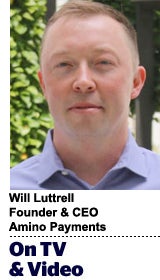 “On TV And Video” is a column exploring opportunities and challenges in advanced TV and video.
“On TV And Video” is a column exploring opportunities and challenges in advanced TV and video.
Today’s column is written by Will Luttrell, founder and CEO at Amino Payments.
This time last year, the digital advertising industry was stinging from a few harsh slaps on the wrist from prominent brand marketers at the IAB Annual Leadership Meeting.
Yet the industry continues to operate with flaws throughout the supply chain. We hurry to spend the whole budget to retain spending power in the next budget cycle. We ignore the laws of math and believe insane share of voice, frequency and reach metrics. We use creative auction mechanics to increase our take.
We’re all to blame.
But there are small signs of change. AT&T and others have pulled advertising from questionable Google content. Publisher adoption of Ads.txt is skyrocketing, reaching 44% in mid-Q4, according to the IAB Tech Lab. Companies like Adobe and Sizmek are making some of their fees transparent to partners. Facebook is trying not to reward bad-quality publishers.
These digital changes are good, but they may not be enough to set the stage for a converged advertising market that includes advanced TV spend and audience-targeted TV placements.
The NewFronts are around the corner and offer a chance to see some public deal-making. Everyone who participates in the NewFronts must know that this event will likely merge with the UpFronts. Even now, buyers are starting to blur the lines, asking for multichannel audience targeting on TV and favoring private marketplace video media buys on digital.
Linda Yaccarino, NBCU’s chairman of ad sales and client partnerships, recently assembled a motley crew of sellers, buyers and digital heads to “fix the ad-supported ecosystem.” If you read between the lines, it’s clear she doesn’t want new forms of TV to get ensnared by digital’s problems.
Wholesale improvements to the digital ecosystem this year are unlikely, but there are important steps that brands can take now to get transparency and quality in a converged market. It would be great to see brands take a public stand at the NewFronts, committing to a more transparent marketplace. Steps could include:
- Building a better supply chain. Brands should start out with transparency in mind and require more transparency for new types of media buys than what was requested for digital.
- Picking premium content over audience scale. On digital, finding audience reach via cheap content usually means fraud, especially with video. For advanced TV buys, the traditional linear TV focus on quality content is an important factor in slowing fraud in the long tail.
- Favoring first- and second-party data for targeting. Advanced TV has interesting new data from set-top boxes, smart TVs and time-shifted digital content. Brands shouldn’t mash this data together with the inaccurate cookie-based third-party audience data that’s rife on programmatic digital media today.
- Requiring publishers to report on unique daily users, not impressions or other metrics that can be falsely inflated. Again, linear focus on GRPs might not offer precision, but it does control for massive data inflation. Impressions and clicks can be gamed more easily than unique people, which can be compared to a variety of panels.
- Using KPIs with teeth. Conversions, sales and unique frequency caps ensure that marketers get real people and value real activity over volume metrics that don’t connect with business goals.
- Sweating the details on contracts. If brands don’t want second-party auctions, third-party data targeting or the use of publishers’ extension partners to reach their volume goals, brands must put it in writing and enforce.
Nobody wants advanced TV to fall to digital complexity the way that print did. TV commercials are the holy grail to brands, and they don’t want the problems of digital advertising to muck that up any more than Ms. Yaccarino does.
The convergence of TV and digital will be a motivating factor for buyers, sellers and middlemen to reach an agreement around quality, transparency and standards that have been missing on programmatic to date. Hopefully, at next year’s IAB meeting, we’ll be cheering some new best practices that will pave the way.
Follow Will Luttrell (@will_luttrell), Amino Payments (@aminopay) and AdExchanger (@adexchanger) on Twitter.












